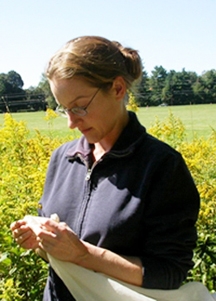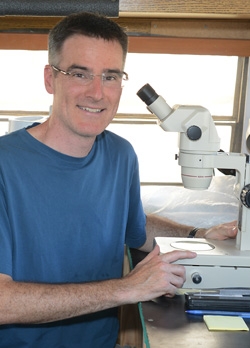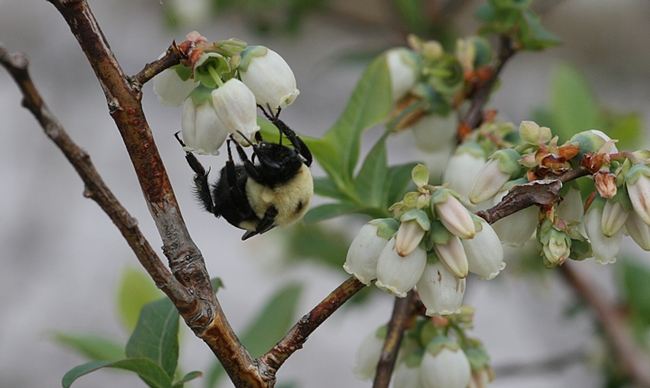

The answer: "Not nearly enough bees are available for crop pollination."
Check out the biodiversity-crop pollination research published today in the journal Science by a team of ecologists led by Rachael Winfree of Rutgers University, New Brunswick, and including Neal Williams of the University of California, Davis.
The abstract:
"Ecologists have shown through hundreds of experiments that ecological communities with more species produce higher levels of essential ecosystem functions such as biomass production, nutrient cycling, and pollination, but whether this finding holds in nature (that is, in large-scale and unmanipulated systems) is controversial. This knowledge gap is troubling because ecosystem services have been widely adopted as a justification for global biodiversity conservation. Here we show that, to provide crop pollination in natural systems, the number of bee species must increase by at least one order of magnitude compared with that in field experiments. This increase is driven by species turnover and its interaction with functional dominance, mechanisms that emerge only at large scales. Our results show that maintaining ecosystem services in nature requires many species, including relatively rare ones."
What they did what to research the number of wild bees found in watermelon, blueberry and cranberry crops on 48 farms in New Jersey and Pennsylvania.
By the numbers:
- more than 100 wild bee species identified
- 3 crops
- 48 farms
- 2 states
- 6 researchers
“We found that maintaining ecosystem services in nature requires many species, including relatively rare ones,” said Professor Winfree. The publication, “Species Turnover Promotes the Importance of Bee Diversity for Crop Pollination at Regional Scales,” appears in the section, Ecology.
For the research, the team counted pollen grains of different bee species to measure bee pollination, tallied the number of bees and the different species pollinating the crops, and then figured out the minimum set of bee species that could meet various pollination needs. Finally, they plotted the cumulative number of bee species needed against the number of sites.
"When you have five (ish) bee species you get enough pollination,” she said “But there are only so many species you can even fit in an experiment. What we wanted to know is, how many bees do real farmers need to pollinate actual farms across an entire state?”
“Any one farm might need only a few species, but different bee species pollinate the different farms, so to pollinate all 50 (ish) farms we needed about 10 times as many species as are needed in smaller scale experiments,” Winfree said. “More than half of the 100 (ish) bee species we saw in the study were needed at some farm for some crop.”
Winfree, reiterating that “we need more bees than we thought,” said the issue is “important because many scientists are concerned that bees are in trouble. There is limited information on how most bee species are doing, but some of the species we do know about are declining. This work shows that preserving lots of bee species is important for food security.”
Said Williams, a professor in the UC Davis Department of Entomology and Nematology: “Bees and other pollinators are critical for the pollination of crops and wild plants around the world and protecting them has become a major concern. A considerable amount of past research has shown that having multiple species improves pollination of many crops; that is pollinator biodiversity benefits crop pollination in many cases.”
“So how many species do we need to ensure reliable crop pollination?” Williams asked. “The answer to this question helps us manage our agricultural and natural lands. Past studies suggest that often just a few bee species can do the job for any one site.”
The study, among the first of its kind, “reveals that when we look across multiple farm sites in a region, we need many more species than experimental studies have suggested in the past,” Williams said.
“At one farm pollination might rely on a handful of species, but across 40-50 farms in a region we need 10 times that number,” he noted. “This is because the most important species change from one place to another. “
So how many bee species are important to ensure crop pollination?
“More than we thought!” Williams said. “Working to promote bee diversity across regions is important for maintaining pollination and secure food systems.”
How can this apply to California? Williams said that "similar patterns likely apply in California, where we have shown benefits of wild bee diversity for watermelon, sunflower and almond pollination. That said, our landscapes differ and we ought to be considering it here in California, too."
What's the next step? "In practice, continuing to think about and approach pollinator diversity and pollinator health as a regional undertaking as well as at single sites," Williams said.
Other co-authors of the study are James Reilly of Rutgers; Ignasi Bartomeus of Rutgers and also with a biological station in Seville, Spain; Daniel Cariveau of Rutgers and the University of Minnesota; and Jason Gibbs of the University of Manitoba, Winnipeg, Canada.
A grant from the National Institute of Food and Agriculture (NIFA) of the U.S. Department of Agriculture funded the data collection research. Winfree conceived the study, oversaw the data collection, led the conceptual development and wrote the manuscript. Williams contributed to the conceptual development and manuscript preparation.
Attached Images:
